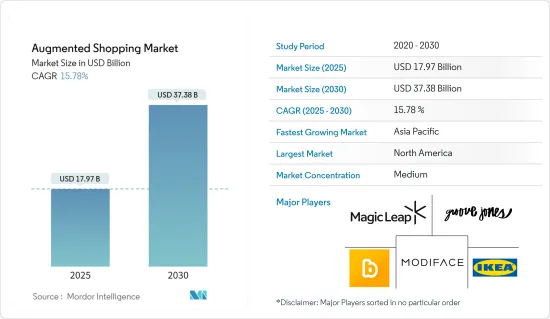PUBLISHER: Mordor Intelligence | PRODUCT CODE: 1636428

PUBLISHER: Mordor Intelligence | PRODUCT CODE: 1636428
Augmented Shopping - Market Share Analysis, Industry Trends & Statistics, Growth Forecasts (2025 - 2030)
The Augmented Shopping Market size is estimated at USD 17.97 billion in 2025, and is expected to reach USD 37.38 billion by 2030, at a CAGR of 15.78% during the forecast period (2025-2030).

Augmented shopping, the fusion of augmented reality (AR) and virtual reality (VR) technologies, is reshaping online and traditional retail. Its core objective is to redefine how consumers browse, select, and buy products. Numerous e-commerce platforms and mobile apps now feature AR, enabling shoppers to virtually test clothing, preview furniture in their homes, and even sample cosmetics. Meanwhile, virtual reality is crafting immersive shopping environments, with virtual showrooms gaining popularity, notably in the automotive and home improvement sectors. Major social media platforms are also adopting AR, enabling users to virtually interact with and purchase products, seamlessly blending socializing with shopping.
Augmented shopping is not solely about enhancing the consumer's shopping experience; it offers high volumes of data to retailers. By monitoring user interactions with AR and VR, businesses can glean insights into consumer preferences, tailoring marketing strategies accordingly. Furthermore, the integration of AR and VR in retail can lead to lower return rates as customers gain a clearer understanding of products pre-purchase. This tech also aids inventory management, with virtual displays reducing the need for physical storage space.
Augmented Shopping Market Trends
Growing Demand for Furniture and Lighting in Asia-Pacific
Augmented reality (AR) is revolutionizing furniture and lighting shopping, allowing customers to preview products in their homes through smartphone apps. This technology helps them assess factors like size, style, and aesthetics, empowering more informed buying choices. With rising incomes, urbanization, and changing consumer tastes, leading markets are experiencing a surge in online furniture sales, spurring the demand for AR-driven shopping.
Growing Augmented Shopping Market in Europe
In recent years, the European augmented shopping market has seen remarkable growth, largely driven by the increasing adoption of AR/VR technologies by both consumers and retailers. Leading the charge, the United Kingdom, Germany, and France collectively dominate, accounting for a substantial 65% share of the European market. Augmented shopping applications, such as virtual product visualization, interactive product guides, and AR-enabled try-on experiences for apparel and cosmetics, are becoming increasingly prevalent. Key growth catalysts include advancements in AR/VR hardware, the rollout of 5G enhancing mobile experiences, and a rising consumer comfort level with immersive shopping. Retailers in Europe are recognizing that the ability to offer personalized, engaging, and convenient shopping experiences will be a crucial competitive edge in the coming years.
Augmented Shopping Industry Overview
The augmented shopping market showcases a moderate level of consolidation, featuring both regional and global players. Market demand is primarily propelled by efficient delivery services, evolving brand preferences, and heightened consumer awareness. Key global market players encompass Magic Leap, Blippar, Groove Jones, IKEA Place, and ModiFace. Notably, established entities, bolstered by substantial investments in marketing and expansion, have notably advanced in the market. Over the study period, these players actively engaged in mergers, acquisitions, and strategic partnerships, all aimed at bolstering their market presence.
Additional Benefits:
- The market estimate (ME) sheet in Excel format
- 3 months of analyst support
TABLE OF CONTENTS
1 INTRODUCTION
- 1.1 Study Assumption and Market Definition
- 1.2 Scope of the Study
2 RESEARCH METHODOLOGY
3 EXECUTIVE SUMMARY
4 MARKET DYNAMICS
- 4.1 Market Overview
- 4.2 Market Drivers
- 4.2.1 The Growing Number of Smartphone and Tablets is Driving the Market
- 4.2.2 Technological Advancements is Driving the Market
- 4.3 Market Restraints
- 4.3.1 The Privacy and Security Concerns is Restraining the Market
- 4.4 Market Opportunities
- 4.4.1 Increasing Smart Shopping is Creating an Opportunity
- 4.5 Value Chain / Supply Chain Analysis
- 4.6 Porter's Five Forces Analysis
- 4.6.1 Threat of New Entrants
- 4.6.2 Bargaining Power of Buyers/Consumers
- 4.6.3 Bargaining Power of Suppliers
- 4.6.4 Threat of Substitute Products
- 4.6.5 Intensity of Competitive Rivalry
- 4.7 Insights on Technological Innovations in the Market
- 4.8 Impact of COVID-19 on the Market
5 MARKET SEGMENTATION
- 5.1 By Component
- 5.1.1 Solutions
- 5.1.2 Services
- 5.2 By Application
- 5.2.1 Furniture and Lighting
- 5.2.2 Beauty and Cosmetics
- 5.2.3 Apparel Fitting
- 5.2.4 Grocery Shopping
- 5.2.5 Footwear
- 5.2.6 Other Applications
- 5.3 Geography
- 5.3.1 North America
- 5.3.1.1 United States
- 5.3.1.2 Canada
- 5.3.1.3 Rest of North America
- 5.3.2 Europe
- 5.3.2.1 Germany
- 5.3.2.2 United Kingdom
- 5.3.2.3 France
- 5.3.2.4 Russia
- 5.3.2.5 Spain
- 5.3.2.6 Rest of Europe
- 5.3.3 Asia-Pacific
- 5.3.3.1 India
- 5.3.3.2 China
- 5.3.3.3 Japan
- 5.3.3.4 Rest of Asia-Pacific
- 5.3.4 South America
- 5.3.4.1 Brazil
- 5.3.4.2 Argentina
- 5.3.4.3 Rest of South America
- 5.3.5 Middle East
- 5.3.5.1 United Arab Emirates
- 5.3.5.2 Saudi Arabia
- 5.3.5.3 Rest of Middle East
- 5.3.1 North America
6 COMPETITIVE LANDSCAPE
- 6.1 Market Concentration
- 6.2 Company Profiles
- 6.2.1 Magic Leap
- 6.2.2 Blippar
- 6.2.3 Groove Jones
- 6.2.4 IKEA Place
- 6.2.5 ModiFace
- 6.2.6 Obsess
- 6.2.7 HoloLens
- 6.2.8 Zugara Inc.
- 6.2.9 PTC Vuforia
- 6.2.10 Apple Inc.*
7 MARKET FUTURE TRENDS
8 DISCLAIMER AND ABOUT US




